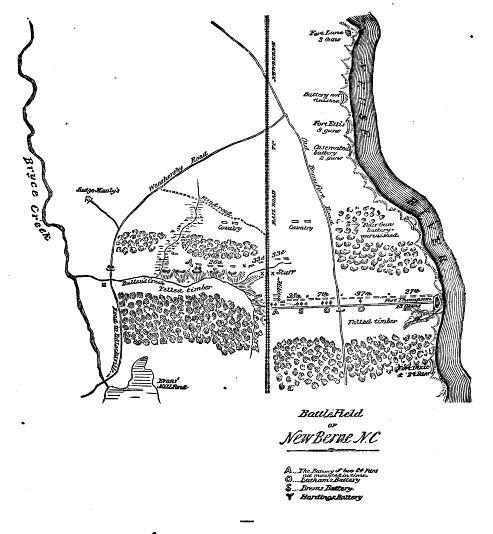Burnside's Success: The Battle of New Bern
/Many people who visit Fredericksburg have the impression that Ambrose Burnside was an idiot and not fit to command the Army of the Potomac. While the Battle of Fredericksburg was indeed a hard loss for the Union, the fact is that Burnside was given command for some reason. That reason lies mainly in his operations in North Carolina.
From September 1861 to July 1862, Burnside commanded the Coast Division, or North Carolina Expeditionary Force, in a campaign to close the North Carolinian coast to Confederate shipping and blockade running. This campaign was marked by joint operations between Burnside’s infantry and the North Atlantic Blockading Squadron under Captain Louis M. Goldsborough. The opening phase of the “Burnside Expedition” was the Battle of Roanoke Island (February 7-8, 1862) and the campaign lasted until June 1862. Once Roanoke surrendered and the Union gunboats destroyed the remnants of the Confederate fleet that had escaped, the Albemarle and Pamilco sounds were open to the Union and all of the cities which depended on them became vulnerable to attack. Burnside chose the important city of New Bern, NC and concentrated his 11,000 men against a Confederate force of only 4,000 under the command of General Lawrence O’Bryan Branch.
The Confederate troops, although outnumbered, had the advantage of an established defensive line. The line stretched from Fort Thompson on the Neuse River to a brickyard along the Atlantic and North Carolina railroad and featured several redoubts (which still exist). Branch decided to extend his line past the railroad into the swamp beyond it, doubling the length of his line along a creek the men used as a defensive position. By doing so, however, a gap appeared in the Confederate line as the line along the creek was farther back than that extending from Fort Thompson.
The Union disembarked and approached the Confederate position on March 13, 1862, supported by their gunboats in the river. Under the cover of the morning fog on March 14th Burnside’s men attacked, one side engaging the enemy’s left while another portion tried to turn the Confederate’s flank at the brickyard. Burnside was only aware that Branch’s line extended to the railroad, not beyond it; fortunately for him, the gap in the Confederate line was held by green militia with only two weeks of training and insufficient weapons. The inexperienced men broke and ran, allowing the Union to cut the Confederate line in two and badly damaging the 26th NC and 35rd NC stationed in the swamp and in reserve. The Battle of New Bern was the “baptism of fire” for the 26th NC; at Gettysburg they would sustain the largest numerical losses of any unit, North or South, during the entire course of the war.
Branch lost 64 killed, 101 wounded, and 413 captured or missing, compared to Burnside's 90 killed, 380 wounded, and a single man captured. New Bern remained in Union control for the rest of the war, and Burnside moved on to his next objective, Beaufort, NC and Fort Macon which surrendered on April 26, 1862. After these successes, the first significant Union victories in the Eastern theatre, Burnside was promoted to major general and his forces were transported back to Virginia, becoming the IX Corps of the Army of the Potomac. At this point he was offered command of that army in the wake of McClellan’s failure on the Peninsula. Burnside refused the position, partly due to loyalty to McClellan and due to his own understanding of the gaps in his military knowledge.
After McClellan failed to pursue Lee’s retreat from the Battle of Antietam, and after three offers of the commanding position, Burnside reluctantly assumed command of the Army of the Potomac on November 7, 1862. The stage was now set for the drama along the Rappahannock river in December……
Part of the New Bern Battlefield is preserved and open to visitation. Initially protected by the Civil War Trust, they handed the ground over to the New Bern Historical Society. Visitors can explore the 25 acre tract through a series of trails aided by a map picked up at the visitor center. Featured is a monument to the 26th North Carolina, dedicated in 2007. Although still in development, it is a site well worth the visit. http://newbernhistorical.org/battlefield-park
Further Reading:
James L. Gaddis, Jr. Richard Gatlin and the Confederate Defense of Eastern North Carolina. Arcadia Publishing, 2015.
William Marvel. Burnside. The University of North Carolina Press, 1991.
Kathleen Logothetis Thompson graduated from Siena College in May 2010 with a B.A. in History and a Certificate in Revolutionary Era Studies. She earned her M.A. in History from West Virginia University in May 2012. Her thesis “A Question of Life or Death: Suicide and Survival in the Union Army” examines wartime suicide among Union soldiers, its causes, and the reasons that army saw a relatively low suicide rate. She is currently pursuing her PhD at West Virginia University with research on mental trauma in the Civil War. In addition, Kathleen has been a seasonal interpreter at Fredericksburg & Spotsylvania National Military Park since 2010 and has worked on various other publications and projects.





